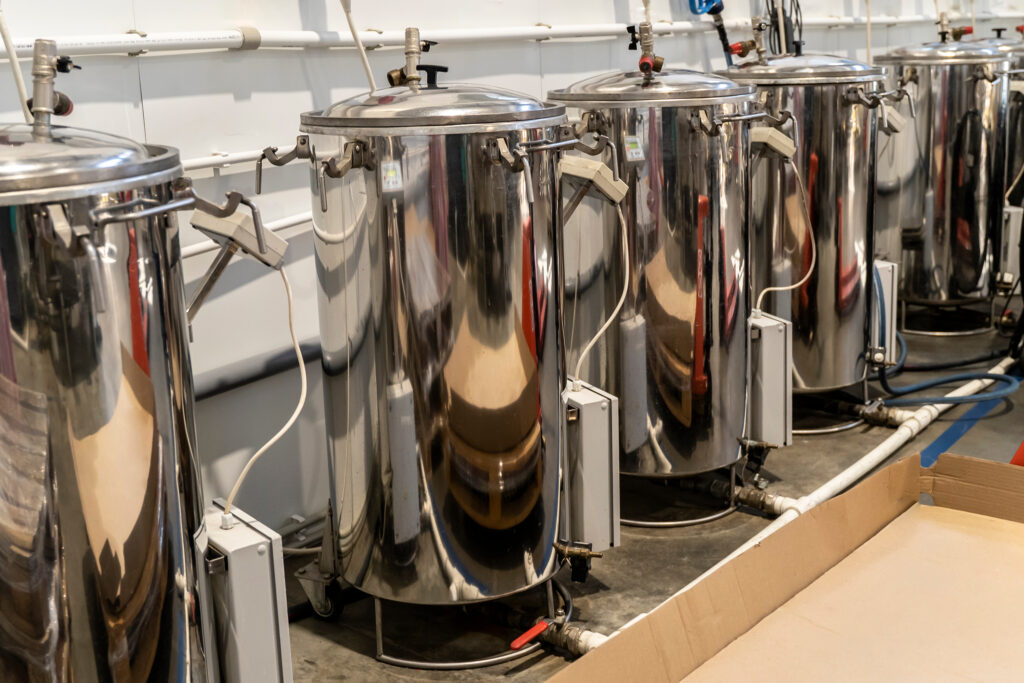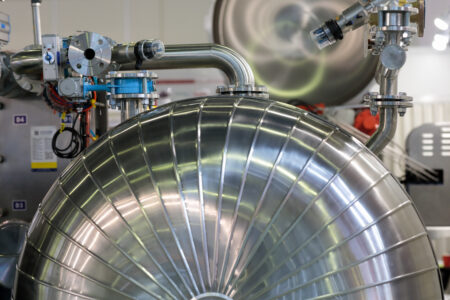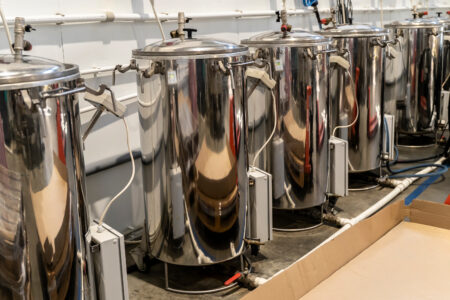
What are the benefits of steam sterilization in food processing?
February 7, 2024 | By Emily Newton
 Autoclave Sterilization in Food Industry.
Photo: Alex Desanshe / Adobe stock
Autoclave Sterilization in Food Industry.
Photo: Alex Desanshe / Adobe stock Failing to clean products and equipment properly could endanger consumers and result in costly fines for food manufacturers. Consequently, choosing the right sanitation method is a weighty and often difficult decision. While it may not be the most obvious choice, steam sterilization deserves consideration.
As the name suggests, steam sterilization uses bursts of hot steam to kill bacteria and other contaminants. As straightforward as the concept is, it has many advantages food and beverage companies can’t afford to overlook.

Closeup of automatic industrial autoclave for food sterilization. Selective focus.
Photo: gen_a / Adobe stock
Minimal cross-contamination risks
One of steam sterilization’s biggest benefits is that it’s a non-contact cleaning method. Other solutions may involve physically wiping surfaces, but this could transfer contaminants from one surface to another if the system fails to kill all pathogens. These methods can also transfer allergens from the cleaning products themselves.
Steam sterilization doesn’t involve physical contact with food or food-touching surfaces. Consequently, it cannot transfer contaminants between food or equipment, ensuring a higher sanitation standard.
The Canadian Food Inspection Agency (CFIA) requires cross-contamination prevention as part of the preventive control plan many food businesses must have and follow by law. In light of this regulation, non-contact cleaning methods like steam sterilization have become far more attractive.
No harsh chemicals
Similarly, steam sterilization lets food and beverage companies kill pathogens without chemical cleaners. The temperature of the steam alone is sufficient. This has several positive implications for worker health and ongoing costs.
Removing chemical cleaners from the equation eliminates the risk of workers inhaling hazardous vapours. Similarly, employees don’t have to worry about skin or eye irritation hazards. Even if other cleaners aren’t toxic, they may contain allergens that could affect some workers or customers, but steam cleaning doesn’t carry this risk.
Nonchemical cleaning has the added benefit of reducing the unique materials needed to sanitize products and equipment. Consequently, food manufacturers can lower their ongoing expenses. Even if steam sterilization systems cost more upfront, these savings may make up for those expenses over time.
Whole-surface coverage
Steam sterilization also ensures even coverage across the entire cleaning surface. Contact or liquid-based sanitation methods may not be able to reach some corners or seams in equipment or food packages. Steam doesn’t have this problem, as vapours fill the shape of any container.
Ensuring even coverage can be challenging in food manufacturing, as cans, bottles and other containers have hard-to-reach edges, curves and corners. Reaching these with a physical cleaning product requires high precision and, likely, slower processing. Even spraying with liquid isn’t ideal, as the spray may splash off surfaces and fail to reach some areas.
Steam doesn’t have any of these restraints. In addition to ensuring more reliable sanitation, this lets manufacturers safely use uniquely shaped food containers without additional cleaning concerns. Custom packaging boosts brand recognition and publicity, offering a competitive advantage.
Potential for automation and connectivity
Another advantage of steam sterilization is that it’s easily automated. Handheld, manual steamers are an option, but using a large stationary steam cleaner is typically more efficient and can operate autonomously.
Steam sterilization systems are also fairly straightforward, making them ideal candidates for Internet of Things (IoT) connectivity. IoT sensors can easily monitor these machines’ performance without adding much complexity. This connectivity minimizes manual data entry for more effective maintenance and efficient cleanliness standard audits.
Automation and connectivity are becoming increasingly crucial to competing amid rising output demands and declining workforce availability. An easily automatable and connected system like steam sterilization helps manufacturers capitalize on this shift.

Autoclave Sterilization in Food Industry.
Photo: Alex Desanshe / Adobe stock
Energy efficiency
Steam sterilization doesn’t require much energy. Steam doesn’t leave as much moisture as liquid-based cleaning, minimizing drying requirements. It also works in short bursts, so food producers don’t have to run their cleaning equipment for extended periods.
While it does take energy to create steam hot enough to kill bacteria, there are many ways to supply this power. It’s easily electrified, opening the door to renewable energy or IoT-driven efficiency improvements. The lack of supporting cleanup or finishing processes also reduces overall energy use within the facility.
This efficiency has two primary benefits. First, it reduces utility expenses. Secondly, it makes the factory and the food it produces more sustainable, helping appeal to an increasingly eco-conscious market.
Water efficiency
Even as a water-based sanitation method, steam sterilization is water-efficient. It uses up to 95 per cent less water than wet cleaning techniques.
Much of this water efficiency stems from thefact that, as a vapour, steam is much less dense than liquid. Consequently, it takes less water to fill the same amount of space and clean as many surfaces. Steam sanitization also doesn’t require any rinsing, further reducing water consumption.
As with steam sterilization’s energy consumpton, this efficiency has environmental and economic benefits. It also minimizes risks from waterborne contaminants that may be present in wet cleaning methods.
Flexibility
Steam sterilization is flexible. Manufacturers can produce high-temperature steam with various equipment, power sources and form factors. As a result, it’s easy to tailor steam cleaning to specific facilities’ needs and adapt it as necessary from there.
High-throughput food processors can use continuously operating steam sterilization equipment over a conveyor belt. Smaller workflows that switch between different products often can use adjustable tabletop sterilizers or handheld steam cleaners for added flexibility. This variety also accommodates varying physical space restrictions and budgets.
Steam sterilization’s flexibility helps food and beverage companies stay agile in a quickly shifting market. As consumer demands change, these systems’ relative simplicity makes it easy to adjust workflows to accommodate production changes.
Steam sterilization has may benefits for food processors
Choosing the best sanitation method involves many complex factors, including health regulations, facility sizes, budgets, and the types of food or containers a company uses. Consequently, the optimal solution varies among businesses, but steam sterilization is an ideal choice for many.
In light of these advantages and rising industry standards, food processors looking for a new sanitation solution should start their search with steam.
